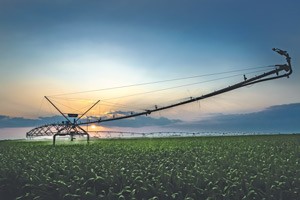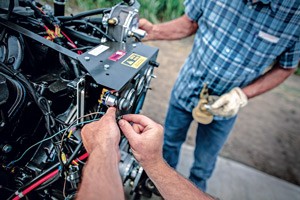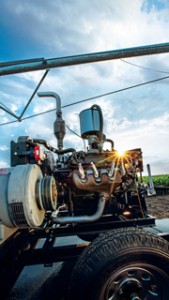Irrigation: Propane poised to overtake diesel engines on the farm

Industrial Irrigation Services’ Jay Canada says propane is a “no-brainer” for stationary irrigation applications. Photo courtesy of the Propane Education & Research Council
Propane autogas has made tremendous strides in the school bus market over the last few years. A number of transportation directors now see the value of switching from diesel to propane, lessening their fleet’s fuel costs while creating a cleaner environment for kids riding their buses.
A similar diesel-to-propane development is brewing in agriculture, says Roy Willis, president and CEO of the Propane Education & Research Council (PERC). The development centers on irrigation engines.
“The economics of using propane make sense compared to diesel,” Willis says. “So as farmers are looking to replace their old diesel equipment, we want to be there.”
Propane-powered irrigation engines aren’t a new phenomenon. They’ve been around for decades, powering the pumps that move water from wells and surface sources to farmers’ crops. Today’s technology is reportedly more efficient and reliable, though, and a number of manufacturers have committed to propane with recent equipment developments.

Today’s propane irrigation engines are reportedly more efficient and reliable, though, and a number of manufacturers have made commitments to propane with recent developments. Photo courtesy of the Propane Education & Research Council
“In the last five years, we’ve had seven manufacturers and 35 new models come to market,” says Cinch Munson, PERC’s director of agriculture business development. “Before, propane irrigation pumps were built to run on gas and converted. They weren’t really efficient. People had a bad perception of them. We just didn’t have the right engines to grow the market.”
But the right engines are here now, according to PERC, and propane marketers are positioned to increase their gallon sales with more widespread use of propane-powered irrigation engines.
“Farmers are big consumers of propane, and offering them new equipment and new engines that are more efficient is the way we’re going to keep their business,” Willis says.

According to USDA, more than 13,000 propane irrigation engines are in use throughout the United States. Photo courtesy of the Propane Education & Research Council
Propane versus diesel
According to the U.S. Department of Agriculture’s (USDA) 2013 Farm and Ranch Irrigation Survey, 603,579 irrigation pumps are in use throughout the United States that require an energy expense.
Electricity powers more than 70 percent of those pumps. Diesel, gasoline, natural gas, propane and other fuels that require expenditures represent the other 30 percent.
Still, propane represents just 2.2 percent of the whole market. That’s 13,444 total units.
“I’ve personally set a goal to be at 5 percent [market share] by the next survey,” says Munson, referring to a USDA survey that will be published in 2018. “It’s going to take all of us pushing it.”
According to Munson, propane has a chance to increase its market share by cutting into existing diesel space. Tier 4 Final emissions regulations of diesel technology, which the U.S. Environmental Protection Agency is phasing in this year, provide an opportunity for propane to replace tens of thousands of diesel engines.
And Tier 4 Final diesel technology is not cheap.

LP gas (propane and butane) represents
2.2 percent of all the irrigation engines in use throughout the United States, according to the U.S. Department of Agriculture’s (USDA) 2013 Farm and Ranch Irrigation Survey. According to USDA, 2,031 pumps are solar powered or powered through other means.
“Diesel fuel was extremely cheap during the real boom in irrigation in the late 1990s or early 2000s,” says Jay Canada, director of sales at Industrial Irrigation Services, a Nebraska company that markets propane and natural gas engines from General Motors and Origin, as well as diesel engines from John Deere and Yanmar. “That’s when the explosive growth happened in the irrigation market. Tier 1 diesel engines were very cost competitive. Now that the pendulum has swung, propane fuel is cheaper and the upfront cost of the [propane] engine is cheaper.”
In fact, Canada says Tier 4 Final diesel engines compared with propane models of the same horsepower can be up to 80 percent more expensive. So couple a diesel engine’s cost with the cost of the fuel, and farmers are more likely to choose propane over diesel – even knowing irrigation engines burn about 1 gallon of diesel to every 1.57 gallons of propane, as Munson says they do.
A 2013 PERC study confirms propane’s advantages. According to the study produced from the 2013 Propane Farm Incentive Program, farmers who installed propane-powered irrigation engines cut their fuel costs by 56 percent compared with similar diesel-powered engines. Farmers who participated in the study also reduced their overall fuel consumption by 37 percent per hour, PERC reports.
“When you figure in the prices, it really calculates out extremely well for propane,” Munson says.
Propane versus others
Although propane faces a winnable battle with diesel in this space, converting farmers from electricity is a more daunting challenge.
“If a farmer has easy access to electricity, then electricity and electric pumps are going to be his most effective way to go,” says Bill Moore, alternative fuel sales manager for Conger LP Gas in Tifton, Ga. “But if that’s not the case and he has to run a line to a back field, then the cost can be $30,000 to $50,000 just to run his power to the field.”
And in those cases, Moore says the farmer’s choice comes down to propane or diesel. Fortunately for propane marketers, farmers are transitioning onto sites electric companies cannot currently accommodate.
“Irrigation [engine] dealers tell me that all the easy electricity has been gotten to,” Moore says. “Now, it’s a matter of transitioning into a back field or a dirt field. More of those sites will be off grid.”
Propane marketers can find opportunities even where electricity is an option, though. Shari Pedersen, a propane marketer with Allied Propane Service in Dixon, Calif., says high-cost electric infrastructure has turned some farmers in her area to propane.
“The local power company charges a fortune to put power poles in,” Pedersen says. “Farmers see the price of a propane engine is reasonable and the installation costs are very reasonable. They can be installed in one day, whereas with the power company it can take weeks. I’ve heard stories of people spending thousands of dollars to put power poles in.”
The electric company in Pedersen’s area has been inconsistent in its pricing, too, she says. That’s another determining factor for farmers.
“The rates are all over the board, and they charge standby fees,” Pedersen says. “There are time-of-use fluctuations in the power prices. So it’s like the stars lined up for propane and the time is now.”
According to Moore, propane’s mobility is a determining factor for some farmers. He says his company has mounted propane tanks onto trailers for farmers, who can then transport the fuel via a truck or tractor to where it’s needed.
“A farmer will call us and say the tank’s at field three,” Moore says. “I have not had any resistance to that setup because it’s a lot more portable and you can’t spill like you do with diesel fuel.”
Farmers can also mount an irrigation engine onto a trailer to access a variety of water sources.
“He’ll hook it up to his four-wheel-drive pickup or tractor and move it from field to field,” Moore says.
Canada adds that propane becomes a viable option over electricity when electric lines must be extended more than a half-mile.
“Electricity has always been viable, but the last eight years or so it’s really taken hold,” he says. “It’s infrastructure driven where they really have it available.”
Natural gas is another competitor – and one with more share of the irrigation engine market than propane – but infrastructure is also an issue.
“If that area doesn’t have a lot of natural gas infrastructure, a dealer is going to be pushing propane engines more,” Canada says.
State of the market
Although the irrigation engine market is shaping into one of the greater possibilities for propane marketers, growing gallons in this area requires a tremendous effort. Establishing relationships with irrigation engine dealers is a first step, and reaching out to farmers at ag events builds their awareness of propane’s role in this area.
This takes time and commitment, though. The industry needs to convince irrigation engine dealers about the benefits of propane, Moore says, and the propane industry needs them to advocate for the engines.
If not, propane marketers can become engine dealers themselves.
“They’ve just done diesel for so long,” Moore says of the traditional irrigation engine dealers. “We continue to train the farmer to ask for the [propane] option. If I talk to an irrigation dealer and he knows he has to have propane power, I become his dealer on the propane side.”
Farmers also need to understand propane’s value in this area. Moore has educated them at the Sunbelt Ag Expo, an annual farm show in Moultrie, Ga., that draws thousands of farmers in a three-day period.
Moore has also met with farmers at local meetings and had success selling irrigation engines that way.
“They’ll do those meetings in every county, and you’ll have about 125 farmers come in to hear about different stuff,” says Moore, who estimates Conger LP Gas sells more than 100,000 gallons of propane each year for use with irrigation engines. “I can go in as a sponsor of the meeting. They let me set up a table with my propane irrigation information. I’ll always carry an engine with me, and they’ll give me five to 10 minutes to say I have the latest propane irrigation engine available for you if you’re looking at swapping out an engine.”
Moore says he exhibited at 40 county meetings from mid-January to mid-March of this year.
“You’re getting straight to the farmer – the guy who’s going to write you the check,” he says. “Once the season starts, it’s hard to catch them.”
According to Moore, one irrigation engine consumes 4,000 to 5,000 gallons of propane during a wet crop season. During a dry crop season, he estimates one engine consumes 6,500 gallons operating at 6.5 gallons per hour over 1,000 hours.
“How many new houses would I have to convert to propane to get anything close to that?” Moore says. “You’re talking 200 houses to get that in south Georgia.”
What is Tier 4?
According to Cummins, an OEM engine manufacturer, Tier 4 refers to a set of requirements from the U.S. Environmental Protection Agency (EPA) to reduce emissions of particulate matter, oxides of nitrogen and air toxics from new, non-road diesel engines.
EPA introduced Tier 4 regulations in two phases. Tier 4 Interim began in 2011, and Tier 4 Final started in 2014. Tier 4 Final is now the emissions standard in place for off-road diesel engines.
Propane industry officials say Tier 4 technology is expensive and that the learning curve for its use and maintenance is intense. Thus, an opportunity exists for alternative fuels such as propane to replace Tier 4 diesel technology.
















